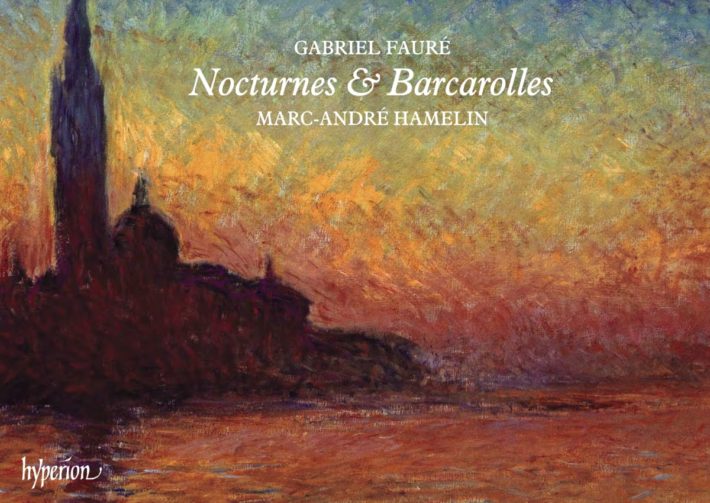Having lived in a period where post Romanticism transitioned into early modernism, Gabriel Fauré experienced the influences of a dynamic musical era. Marc-André Hamelin’s new release for Hyperion features three sets of Fauré’s works.
The composition of the 13 Nocturnes spans across almost 50 years, but each is a gem that shows Fauré’s remarkable ability to fit complex musical ideas into a relatively compact form. Where Chopin’s Nocturnes have a quintessential air of nuance and fragility, Fauré’s can be emotionally gripping and at times, raw. Such is the case with the E-flat minor Nocturne (track 1). Hamelin masterfully uses the descending line to drag us from a gently poignant treble to achingly desolate bass.
Fauré’s Nocturnes generally have an element of ‘heaviness’ to them that can be attributed to an ample use of the bass register; this creates quite the interesting juxtaposition when paired with with a bel canto melody as we hear in Op. 33 No. 3 (track 3). The major key doesn’t necessarily make the work ‘happy’ but more dreamy, nostalgic, and a tad Chopinesque. It is the considerable difference in registration that sets up a subtle yet interesting conflict: the melody, which yearns for something in the distance, feels constantly pulled back down by the willful bassline.
The complexity of these Nocturnes across the board can be attributed to the intricate contrapuntal textures that Fauré often favors — the intertwining of lines and appearance of nestled inner voices create a rich and dynamic soundscape that Hamelin highlights in his playing. One particularly lovely performance is Op. 84 No. 8 (track 8). Here, the melody weaves in and out of the lower, middle, and upper voices, creating the Lisztian 3-handed effect. The pianist’s handoffs are not only seamless but reflect a wealth of characters from sweeping and rhapsodic to mellow and sparkling.
Related Classical Music Reviews
- Review: Fauré – Requiem, Poulenc – Figure Humaine, Les Siècles, Ensemble Aedes, Romano
- Review: “…Le Temps perdu…” – Imogen Cooper, Piano
- Review: Chanson d’Amour – Sabine Devieilhe, Alexandre Tharaud
- Review: “L’Album des Six” – Corinna Simon, Piano
Much like the Nocturnes, the Barcarolles also span across several decades (1882-1921, to be exact). Fauré creates 13 distinctive versions of this stylized gondoliers’ song, all of which are linked by the typified rocking rhythm of a gently swaying boat. On the note of gentleness, I did find the Barcarolles a little less emotionally intense than his Nocturnes—but certainly no less beautiful. What the cycles do have in common, though, is a vibrant and multidimensional perspective.
IWhether intentional or not, Fauré seems to create an interesting arc-like trajectory through the Barcarolles: he proceeds gently through the earlier ones — the wholly calm A minor (No. 1), a charming and lyrical G major (No. 2), a pensive A-flat (No. 4), and a dreamy E-flat (No. 6). Intensity, however, builds around halfway point. The D minor (No. 7) is tense and anguished, and No. 8, despite being in a major key, has a rhapsodic and impassioned second half. The final Barcarolles are noticeably calmer but do have their peaks of high drama. The final one in C major doesn’t necessarily close the set so much as it leaves the reader reflecting on Fauré’s unabashed inclusion of angular and even jarring intervals throughout.
Of all the Barcarolles, No. 10 in A minor (track 23) was probably my favorite. It is a fine example of how Fauré uses harmony to create stark contrasts and alluring mystery. Listen to the opening, and hear how the melody seems to waver between a somber and sinister personality as it makes its way through shifting consonance and dissonance. The recapitulation of the earlier material in the final section is very much a complex and exhilarating journey through turbulent chromaticism, but the pianist makes the left hand theme a resounding voice of reason that guides us through.
This is a top-notch effort from Hamelin, whose artistry comes through across both sets and the Dolly Suite. The performances are contemplative and never rushed but still deliver drama and excitement. The sound engineering, responsive to his musical sensitivities, only elevates an already fine interpretation. This is one album I will come back to in hopes that repeated listens will unlock more angles of Fauré’s writing.

Fauré – Nocturnes & Barcarolles
Marc-André Hamelin – Piano
Hyperion, CD A68331-2
Recommended Comparisons
Perlemuter | Stott | Collard | Thyssens-Valentin
Read more classical music reviews or visit The Classic Review Amazon store
Follow Us and Comment:
[wd_hustle id=”HustlePostEmbed” type=”embedded”]











